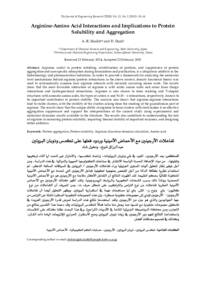Document
Arginine-amino acid interactions and implications to protein solubility and aggregation.
Contributors
Shah, D., Author
Publisher
Sultan Qaboos University.
Gregorian
2015
Language
English
English abstract
Arginine, useful in protein refolding, solubilization of proteins, and suppression of protein aggregation and non-specific adsorption during formulation and purification, is a ubiquitous additive in the biotechnology and pharmaceutical industries. In order to provide a framework for analyzing the molecular level mechanisms behind arginine/protein interactions in the above context, density functional theory was used to systematically examine how arginine interacts with naturally occurring amino acids. The results show that the most favorable interaction of arginine is with acidic amino acids and arises from charge interactions and hydrogen-bond interactions. Arginine is also shown to form stacking and T-shaped structures with aromatic amino acids, the types of cation–π and N–H…π interactions, respectively, known to be important contributors to protein stability. The analysis also shows that arginine-arginine interactions lead to stable clusters, with the stability of the clusters arising from the stacking of the guanidinium part of arginine. The results show that the unique ability of arginine to form clusters with itself makes it an effective aggregation suppressant and support the interpretations of the current study using experimental and molecular dynamics results available in the literature. The results also contribute to understanding the role of arginine in increasing protein solubility, imparting thermal stability of important enzymes, and designing better additives.
Member of
ISSN
1726-6742
Resource URL
Citation
Shaikh, A. R., & Shah, D. (2015). Arginine-amino acid interactions and implications to protein solubility and aggregation. The Journal of Engineering Research, 12 (2), 1-14.
Arabic abstract
يعد الأرجينين، المفيد في طي وذوبان البروتينات، وإخماد تكدسها، والامتزاز غير المحدد لها أثناء تركيبها وتنقيتها، من مواد الإضافة المحسنة الواسعة الانتشار في صناعات التكنولوجيا الحيوية والدوائية. في هذه الدراسة، ومن أجل توفير إطار لتحليل آليات المستوى الجزيئية وراء تفاعلات الأرجينين / البروتين في السياقات السالفة الذكر، تم استخدام نظرية كثافة الدالة من أجل الفحص بمنهجية لكيفية تفاعل الأرجينين التي تحدث الأحماض الأمينية المتكونة تلقائيا بحكم الطبيعة. لقد أظهرت النتائج أن التفاعل الأكثر ملاءمة مع الأرجينين هو مع الأحماض الأمينية الحمضية وينشأ ذلك بسبب الشحنات الكهربية والروابط الهيدروجينية. ولقد أظهر كذلك الأرجينين مع الأحماض الأمينية العطرية تفاعلات من نوع التراص والتراكيب على شكل حرف ت ، ومن المعروف أن التفاعلات من نوع كاتيون- باي ونوع ن ۔ اتش. باي لها مساهمات مهمة في استقرارية البروتين. ويظهر التحليل أيضا أن تفاعلات الأرجينين- الأرجينين تؤدي إلى مجموعات عنقودية مستقرة، وإن هذه المجموعات العنقودية المستقرة ناشئة عن التراص من جهة الجوانيدين والذي هو جزء من الأرجينين . ولقد استخدمنا نتائج هذه الدراسة لعرض قدرة الأرجينين الفريدة في تشكيل مجموعات عنقودية مع نفسها مما يجعل منه مانعا فعالا لتكدس البروتينات وقد دعمنا هذا التفسير بنتائج من التجارب ومن محاكاة الديناميكا الجزيئية المتاحة في الأدبيات (المراجع). وفي هذا البحث علقنا كذلك على الملابسات واستخدامنا النتائج لفهم دور الأرجينين في زيادة ذوبان البروتين ومنح الاستقرار الحراري للإنزيمات الهامة ذات الشأن، وكذلك في تصميم مضافات أفضل.
Category
Journal articles

